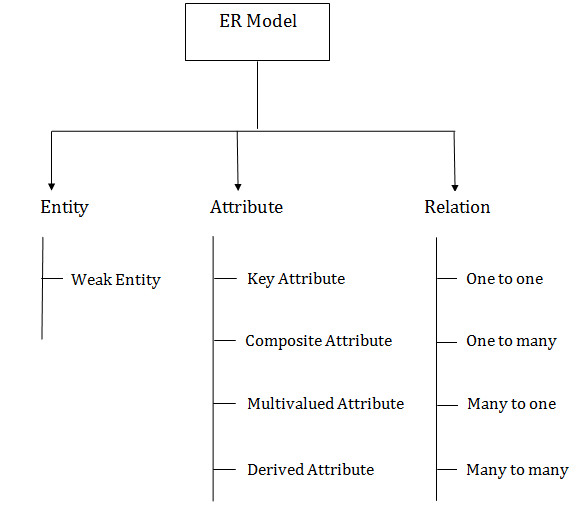
The ER (Entity-Relationship) model is a conceptual data model used in database design. It represents the data in terms of entities, attributes, and relationships. Here are the basic concepts of the ER model:

- Entity: An entity is a real-world object, concept or thing with an independent existence that can be easily distinguished from other objects. In a database, an entity is represented as a table, and each row in the table represents an instance of the entity.
- Attribute: An attribute is a characteristic or property of an entity that describes it. For example, in an entity called “Customer”, “Name”, “Address”, and “Phone Number” could be attributes. In a database, attributes are represented as columns in a table.
There are many different types of attributes defined in the ER database model, some of which are listed below:
- Simple attributes are those that have values that are atomic and cannot be further subdivided. age of the student, for instance.
- A composite attribute is one that combines more than one simple attribute. For instance, the address of a student will include the house number, street name, pin code, etc.
- Derived attributes are those that aren’t actually part of the overall database management system but are instead created by using other attributes. for instance, the typical age of a class.
- Single-valued attribute: They have a single value, as their name would imply.
- Multi-valued attribute: And, they can have multiple values.
- Relationship: A relationship is an association between two or more entities. It represents how the entities are connected to each other. In a database, relationships are represented as links between tables. The number of participating entities in a relationship defines the degree of the relationship.
- Binary = degree 2
- Ternary = degree 3
- n-ary = degree
- Cardinality: Cardinality refers to the number of occurrences of one entity that can be associated with the number of occurrences of another entity in a relationship. There are three types of cardinalities: one-to-one, one-to-many, and many-to-many.
- Primary Key: A primary key is a unique identifier for a record in a table. It is used to ensure that each record in the table is uniquely identified and can be easily accessed. In the ER model, a primary key is represented as an attribute of the entity.
- Foreign Key: A foreign key is a field or combination of fields in a table that refers to the primary key of another table. It is used to establish a relationship between two tables.
The ER model provides a visual representation of the database and helps to ensure data integrity by defining the relationships between entities. It is a widely used model in database design due to its flexibility, scalability, and ease of use.
Note: also read about Data Models – DBMS
Follow Me
Please follow me to read my latest post on programming and technology if you like my post.
https://www.instagram.com/coderz.py/
https://www.facebook.com/coderz.py
Staying up to the mark is what defines me. Hi all! I’m Rabecca Fatima a keen learner, great enthusiast, ready to take new challenges as stepping stones towards flying colors.
Leave a Comment
You must be logged in to post a comment.